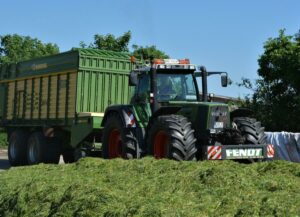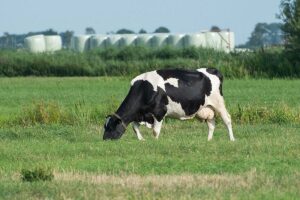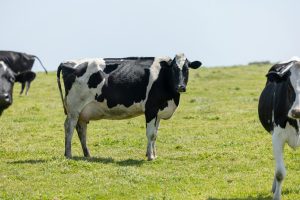Álvaro García
Holstein Friesian cows dominate global dairy production due to their superior milk yield. However, their short productive life, high health costs, and fertility problems threaten farm profitability and sustainability. In contrast, Simmental, a dual-purpose breed, produces less milk per lactation but exhibits greater metabolic resilience, lower veterinary costs, and longer productive lifespan. A recent study (Ruda et al. 2025) compared multiparous cows of both breeds under identical conditions, assessing metabolic adaptation 42 days before calving and at day 21 postpartum. Holsteins produced more milk but lost body weight, showed elevated branched-chain amino acids (BCAA), α-amino adipic acid, and kynurenine, reflecting greater catabolism and oxidative stress. Simmentals maintained body reserves, had lower oxidative stress, and more stable metabolite profiles.
Based on the metabolic findings of Ruda et al. (2025), we modeled the economics of Holsteins and Simmentals under European conditions. Holsteins earned ~€500 more per cow annually, but their shorter lifespan (2.7 vs 4.5 lactations) reduced lifetime profit (€9,070 vs €13,694). Over 10 years per stall, Holsteins remained slightly ahead (€33,600 vs €30,400), yet when health and fertility losses exceeded ~€316 per lactation, Simmentals became more profitable. Thus, Holsteins suit intensive, yield-focused systems with strong veterinary support, while Simmentals offers greater long-term resilience and sustainability.
Introduction
The transition from late gestation to early lactation challenges the metabolism of high-yielding dairy breeds. Holsteins, selected intensively for milk production, typically experience deep negative energy balance, mobilizing fat and protein reserves, elevating NEFA and BHBA, and predisposing them to oxidative stress, insulin resistance, and production diseases such as ketosis, displaced abomasum, and infertility. These conditions contribute to their short herd life, averaging only 2.5–2.7 lactations in the U.S.
Dual-purpose Simmentals, though yielding less milk, demonstrate greater metabolic stability, reduced disease incidence, and longer productive life (4–5 lactations). Given the excessive costs of culling, replacement, and veterinary interventions, a comprehensive evaluation of both biological resilience and economic performance is required to determine whether Holstein’s higher yield justifies their greater losses compared to Simmental.
A recent study
In a study by Ruda et al. (2025) multiparous cows of both breeds were kept under identical housing, feeding, and management conditions. Blood was collected 42 days before calving (anabolic state) and 21 days postpartum (catabolic state). Classical blood chemistry and targeted metabolomics were assessed. Milk yield, milk composition, body weight (BW), and body condition score (BCS) were recorded. Economic modeling considered annual and lifetime profitability, incorporating milk income, health/fertility losses, replacement costs, beef value, and productive lifespan. Sensitivity analyses identified thresholds where Simmental surpassed Holstein profitability.
Holsteins produced ~20% more milk in early lactation but lost BW and BCS. Simmentals maintained body condition but produced less milk. Holsteins showed higher BHBA, reduced insulin, elevated BCAA, and oxidative stress markers. Simmentals showed more stable amino acid profiles and lower oxidative stress.
Annual net margin:
- Holsteins ≈ €3,900
- Simmentals ≈ €3,400.
Lifetime net:
- Holsteins ≈ €9,070
- Simmentals ≈ €13,694
Per stall:
- Holsteins ≈ €33,600
- Simmentals ≈ €30,400
Break-even sensitivity showed that if Holsteins incur more than €316 extra losses per lactation (because of any pathology), Simmentals surpass them even per stall.
Holstein maximize milk yield but at the expense of metabolic stability, health, and longevity. Their higher annual margin is fragile, easily eroded by disease and fertility costs. Simmentals balance lower milk production with metabolic resilience, longer productive life, and stronger beef value. Their lifetime profitability per cow surpasses Holsteins, and in farms with elevated losses, Simmentals also become superior on a per-stall basis. Holsteins are suited for intensive, yield-focused farms with strong veterinary management. Simmentals are better adapted to sustainable, low-input, or dual-purpose systems, where health, longevity, and beef income are prioritized.
Do higher yields justify holstein-associated losses?
To evaluate whether Holstein cows’ higher production compensates for their health-related drawbacks compared to Simmental’s, we must balance milk income against disease, fertility, and culling costs.
Milk income difference
- Holstein cows in this study produced ~20% more milk than Simmentals in early lactation.
- Assuming annual lactation yield:
- Holsteins ≈ 10,000 kg milk/year
- Simmentals ≈ 7,500–8,000 kg milk/year
- With an average milk price of €0.45/kg (2025 EU values):
- Holsteins milk income ≈ €4,500/year.
- Simmentals milk income ≈ €3,400–3,600/year.
- Income advantage of Holsteins: €900–1,100 per cow per year.
Health and fertility costs
- Holstein’s have higher rates of metabolic disorders (ketosis, displaced abomasum, mastitis). Average extra veterinary & treatment costs: €200–300 per cow per year (EU herd data).
- Reduced fertility:
- Holsteins = longer calving interval (average 420–440 days) vs Simmentals (380–400 days).
- Each extra open day costs ~€3–5. Over 40–50 days, which equals €150–250 per cow per year.
- Involuntary culling/replacement:
- Holstein productive lifespan = ~2.5–3 lactations.
- Simmental = 4–5 lactations.
- Shorter lifespan means higher replacement cost, adding ~€150–200 per cow per year for Holsteins.
Beef and dual-purpose value
- Simmentals (dual-purpose) produce heavier calves and higher cull cow value.
- Extra beef value: €150–200 per lactation compared to Holsteins.
Net balance (per cow per year, average EU conditions)
Annual economic comparison of Holstein and Simmental cows. | |||
Factor | Holstein | Simmental | Difference |
Milk income | €4,500 | €3,500 | +€1,000 Holstein |
Vet/health costs | –€250 | –€100 | –€150 Holstein |
Fertility losses | –€200 | –€100 | –€100 Holstein |
Replacement cost | –€200 | –€100 | –€100 Holstein |
Beef/cull value | +€50 | +€200 | –€150 Holstein |
Net margin | €3,900 | €3,400 | +€500 Holstein |
Although Holsteins generate ~€500 more net income per year per cow in this model, this advantage is fragile. Farms facing higher disease incidence, fertility problems, or culling in Holsteins may see these costs eliminate or exceed the milk advantage. In contrast, Simmentals offer greater stability, longer productive life, and beef income, which can outweigh lower milk yield, especially in low-input or mixed milk-meat systems. Moreover, the cumulative effect of fewer replacements, reduced veterinary interventions, and higher cull cow value strengthens the long-term economic resilience of Simmentals. This highlights that breed profitability cannot be judged on milk yield alone but must consider the integrated effects of health, fertility, longevity, and carcass value across the cow’s lifetime.
Annual economic comparison of Holstein vs Simmental cows.
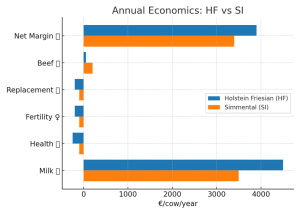
Holstein cows generate more milk income per year (+€1,000 vs Simmental), but this advantage is offset by higher health, fertility, and replacement costs. Simmental benefit from greater beef value and lower losses. Net annual margin remains ~€500 higher for Holsteins, though this difference is fragile and sensitive to disease incidence.
Lifetime net profit per cow (Holstein vs Simmental).
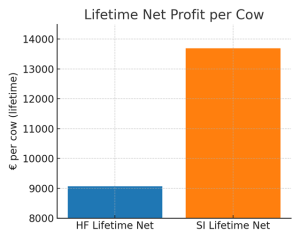
Although Holsteins generate more milk annually, their shorter herd life (2.7 lactations) reduces lifetime returns. Simmentals, with longer productive life (4.5 lactations), achieve ~€4,600 higher lifetime profit per cow.
Ten-year per-stall net profit for Holstein vs Simmental.
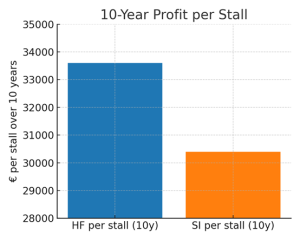
When scaled to a stall for over 10 years, Holsteins slightly outperform Simmentals (€33,600 vs €30,400). This is because more Holsteins cycle through the stall despite higher replacement costs.
Sensitivity analysis shows break-even point where Simmental surpass Holstein once extra penalties of the latter are included.

If Holsteins incur >€316 extra health/fertility losses per lactation, Simmentals overtake them even in stall-level profitability. This threshold is realistic in herds with high culling and disease incidence.
Holsteins deliver unmatched milk yield and a modest annual edge (~€500/cow), but their short lifespan (2.7 lactations) and health costs reduce lifetime profit (€9,070 vs €13,694 for Simmentals, SI). Over 10 years per stall, Holsteins remain slightly ahead (€33,600 vs €30,400), yet this margin vanishes if extra losses exceed €316 per lactation. Holsteins suit intensive, yield-driven herds with strong veterinary oversight, while Simmentals offer greater longevity, dual-purpose value, and long-term resilience. In short, Holsteins win in annual output, Simmentals in lifetime stability.
The full list of references used in this article is available upon request.
© 2025 Dellait Knowledge Center. All Rights Reserved.






